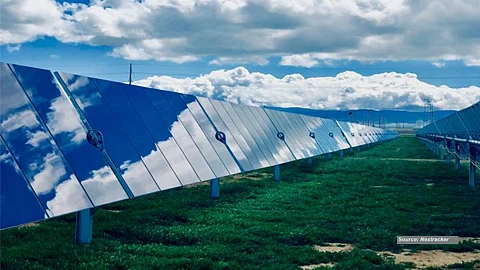

Key takeaways
Nextracker’s TrueCapture uses AI and machine learning to optimize panel angles dynamically, maximizing energy capture
Features like SmartCapture and DiffuseBoost adjust panels based on shading and light conditions, with targeted zone controls
TrueCapture is bankable and offers a trial phase to demonstrate performance gains before final implementation
In solar trackers, while the hardware functions much like the muscles of a body, providing the structural support and movement required to position solar panels effectively, the controllers serve as the brain. They smartly direct these movements through advanced tracking algorithms. Trackers increasingly rely on sophisticated controllers and AI algorithms to optimize their performance. These technologies enable the trackers to adjust the positioning of solar panels dynamically throughout the day, capturing maximum sunlight by responding to changing solar angles and environmental conditions.
Nextracker's TrueCapture is one such intelligent, self-adjusting tracker control system designed to increase energy yield on solar farms. This flagship software suite integrates sophisticated algorithms and machine learning to continuously refine the tracking of solar panels throughout the day. TrueCapture enables individual solar trackers to adjust their angles in response to various environmental conditions, such as shading and uneven ground. The company’s senior business development manager for the EMEA region Antonio Buiza detailed the latest advancements associated with TrueCapture at the TaiyangNews Conference on Solar Power Plant Developments 2024 (see presentation here).
The TrueCapture suite has 2 primary features: SmartCapture and DiffuseBoost. The latter optimizes the panels' positions under diffuse light conditions, which are common during cloudy or hazy weather, thus improving the capture of available sunlight. The system turns the panels into a skyward-facing position that will maximize not only the exposure to global irradiance but also the reflected one in case the plant is using bifacial panels. Nextracker has added a new feature called Zonal Diffuse, which allows the site to be dynamically divided into multiple zones in real-time. This cloud tracking system uses not only sensors but also smart models that track the passing clouds, enabling a more targeted response to passing clouds. When the system detects the passing cloud, only the specific zone shadowed by the passing cloud switches to diffuse mode, while the rest of the plant can continue tracking. That means the entire plant would not go into the diffused mode. The system checks the status every 2 minutes, facilitating a more optimized way to handle the partial clouding scenarios (see Global Solar Tracker Market Sees Significant Growth).
SmartCapture addresses issues of row-to-row shading, which can be particularly problematic in hilly or uneven terrain, typically known as 3D backtracking. Nextracker’s systems map the plant in a real digital twin, but not based on engineering documentation on a layout or a topography from AutoCAD. It is based on 3D mapping of the PV site where the tracker has been commissioned, meaning it is accurate. The approach helps to eliminate the underperformance due to the misalignment from the engineering to the construction phase. On top, Nextracker offers an additional level of optimization called SplitBoost, specially designed for half-cell modules. During the early hours of the morning or last hours of sunlight before dawn, essentially when the row-to-row shading is at maximum, the system is capable of evaluating the best mode to deliver higher energy yield between backtracking and split boost. The software intentionally shades the bottom half of the module accurately to optimize the angle of incidence for the top half of the panel. Otherwise, using backtracking, the entire panel is nearly flat. TrueCapture helps achieve up to 4% total annual energy gain, claims Nextracker (see Solar Tracker Market Expansion Driven By Global Players And Regional Growth).
TrueCapture is part of its advanced software license, which is much more than TrueCapture itself, said Buiza. It includes a navigator, which is kind of the company’s own version of SCADA. It encompasses advanced solutions like hail stowing, flood stowing, snow stowing and other management tools. Buiza showed in his presentation the hail stowing option as an example. It is a navigator interface, which brings the tracker to a hail stow position before the hail actually happens. Based on a forecasting system, the system assesses the probability of hail, the distance from the storm or the size of the hail and the anticipated damage. Then the software moves the solar modules into the hail stow position. The company has constantly been evaluating various stowing positions to safeguard the modules from such natural calamities. Another important aspect of TrueCapture – it’s bankable, according to Buiza, meaning the users can actually include its cost in their project financing models.
Nextracker is also offering a so-called evaluation possibility with its TrueCapture. As part of this, the company installs its control software in controlled blocks of an operational plant at different slopes and shows the performance gain with TrueCapture in diffused irradiance conditions and back-tracking. After the evaluation period, the company offers a customized pricing model according to the gain in energy yield.
The text is an excerpt from the latest TaiyangNews Solar Trackers Market Survey 2024, which can be downloaded for free here.
